- News
- Reviews
- Bikes
- Accessories
- Accessories - misc
- Computer mounts
- Bags
- Bar ends
- Bike bags & cases
- Bottle cages
- Bottles
- Cameras
- Car racks
- Child seats
- Computers
- Glasses
- GPS units
- Helmets
- Lights - front
- Lights - rear
- Lights - sets
- Locks
- Mirrors
- Mudguards
- Racks
- Pumps & CO2 inflators
- Puncture kits
- Reflectives
- Smart watches
- Stands and racks
- Trailers
- Clothing
- Components
- Bar tape & grips
- Bottom brackets
- Brake & gear cables
- Brake & STI levers
- Brake pads & spares
- Brakes
- Cassettes & freewheels
- Chains
- Chainsets & chainrings
- Derailleurs - front
- Derailleurs - rear
- Forks
- Gear levers & shifters
- Groupsets
- Handlebars & extensions
- Headsets
- Hubs
- Inner tubes
- Pedals
- Quick releases & skewers
- Saddles
- Seatposts
- Stems
- Wheels
- Tyres
- Health, fitness and nutrition
- Tools and workshop
- Miscellaneous
- Tubeless valves
- Buyers Guides
- Features
- Forum
- Recommends
- Podcast
TECH NEWS
Just in: Velocite Geos 2.0
If you’ve not heard much about Velocite before, that’s because the brand has been around only since 2008 and it has just got UK distribution. The Geos is the first level carbon bike in the lineup, designed to be a lightweight, stiff and fast race bike, but also comfortable enough to ride on a long sportive or a multi-day event... which, admittedly, is the same as many other manufacturers promise.
All of Velocite’s frames come in different Shimano and SRAM builds; we have the 2.0 version of the Geos here which comes with a choice of groupsets: Shimano Ultegra (£3,160) or, as we have here, SRAM Force (£3,270). If you go for the 3.0 model you choose between Shimano 105 (£2,600) or SRAM Apex (£2,500). Choose the 1.0 version and it’s the top end kit from those two manufacturers: Dura-Ace (£5,110) or Red (£4,995).
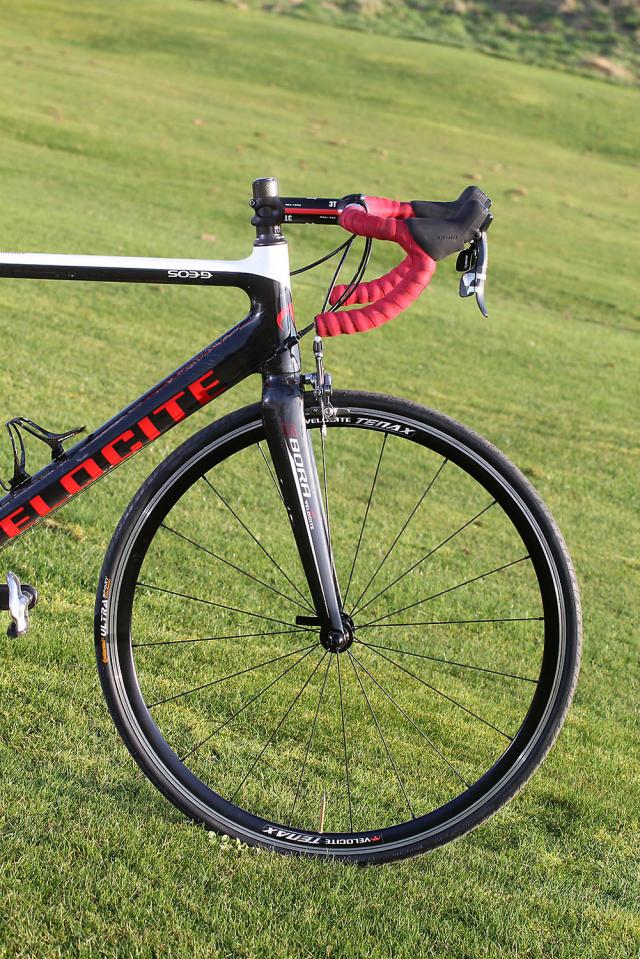
But we’re getting ahead of ourselves. Back to the frame… The Geos is a unidirectional carbon-fibre monocoque that boasts many of the features we’ve come to associate with high-end performance bikes over the past few years.
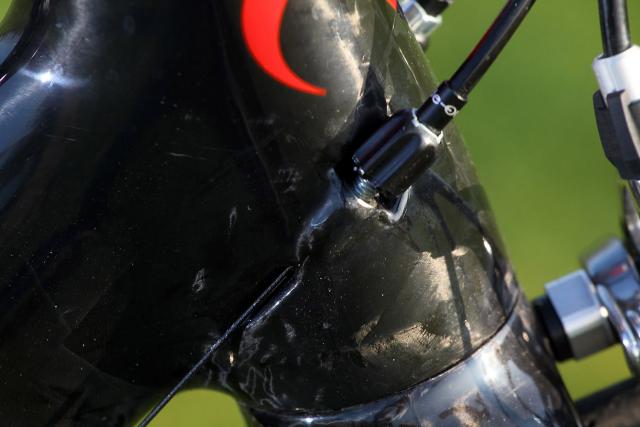
So, you get a tapered head tube with a 1 1/8in upper bearing at the top flaring out to 1 1/2in at the bottom to increase strength and torsional stiffness, and the bottom bracket is of the oversized BB30 variety – again to increase stiffness and also to drop the weight.
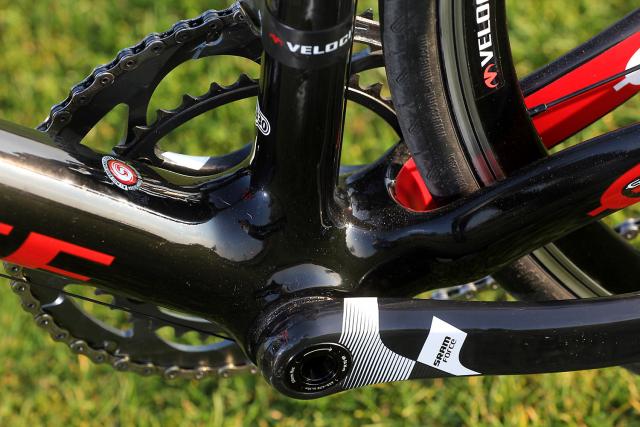
The down tube is designed to be stiff too – are you starting to notice a theme here? It’s up to 60mm in diameter while the chainstays are 45mm tall as they leave the bottom bracket shell.
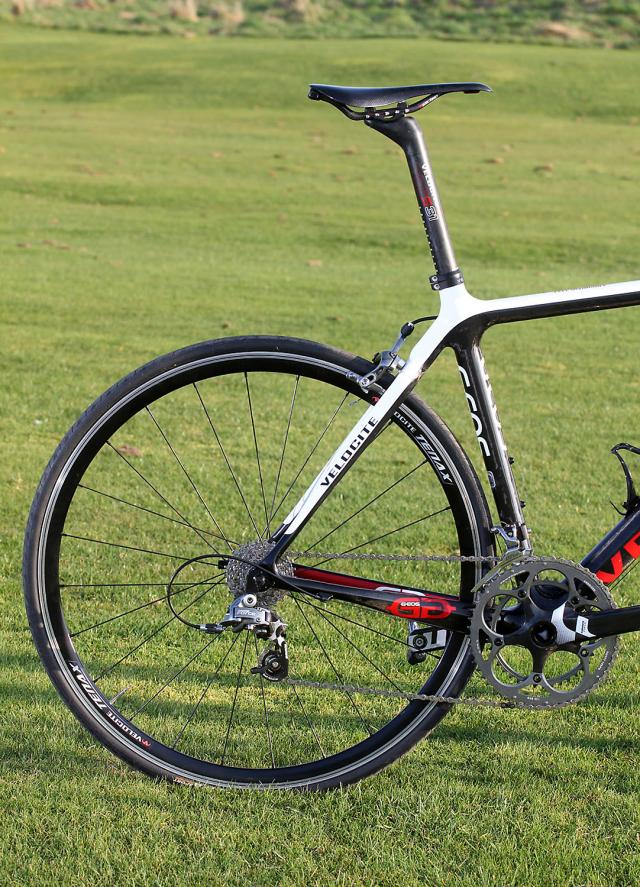
Velocite use a compact geometry with a sloping top tube so the front triangle is pretty small for the bike size and the same goes for the back end. The aim of the small triangles is, again, to provide more stiffness.
Speaking of the geometry, the Geos comes in four different sizes from small to extra large. We have the medium model here. Despite a 547mm top tube, the sloping geometry means that the seat tube is just 480mm, so if the reach is right for you, chances are that you’ll have a lot of seat post exposed. The idea is that you’ll get enough flex there to keep the ride comfy. That’s a concept that Giant and other adopters of compact geometry have been pushing for years.

The dropouts are carbon as are the headset races, which drops the weight just a smidge. The cable stops are integrated into the head tube while the rear brake cable is routed inside the top tube.

The fork plugged in up front is Velocite’s own Bora S which they use across most of the road range. It’s a full high-modulus carbon monocoque right down to the dropouts and Velocite claim a light 360g weight.
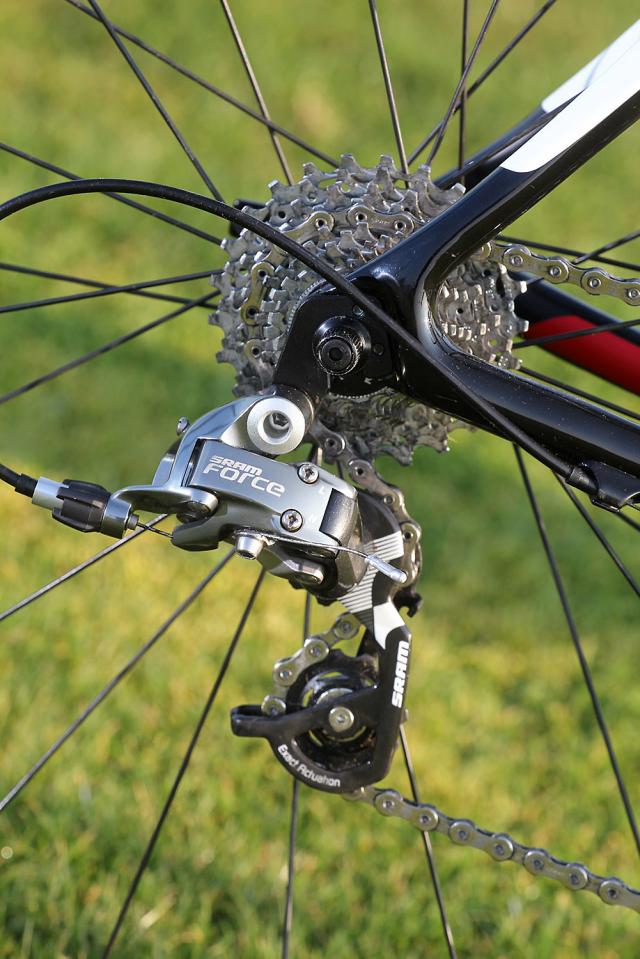
The 2.0 comes with a SRAM Force spec – Force being the second tier groupset after Red – although, as we said, you can opt for a slightly cheaper Ultegra build if you prefer.

You’d usually get a Prologo saddle on this bike but our review model has Velocite’s own SCS model instead. SCS stands for Soft Carbon Shell. As you can see, there’s no padding here, it’s just a shell that’s designed to flex a little to provide comfort. The carbon rails are mounted on a leaf spring at the back end and there’s a cutout in the middle. Velocite’s claimed weight for the saddle is just 113g and bought separately it would cost you £130.

The Geos rolls on Velocite’s own Tenax alloy wheels which have an official weight of 1,698g. If you prefer, you can upgrade to Fulcrum wheels; speccing a pair of Racing 3s will cost you £169 extra. Or you could go for Velocite’s deep section carbon wheels if you like, but that’ll put a big chunk on the price.
So, there you go… this is the first Velocite that we’ve ever had in for testing on Road.cc so we’re pretty eager to find out how it rides. Even now it’s heading off to VecchioJo’s place so standby for a review shortly. In the meantime, check out the full range at www.velocite-bikes.co.uk.
Mat has been in cycling media since 1996, on titles including BikeRadar, Total Bike, Total Mountain Bike, What Mountain Bike and Mountain Biking UK, and he has been editor of 220 Triathlon and Cycling Plus. Mat has been road.cc technical editor for over a decade, testing bikes, fettling the latest kit, and trying out the most up-to-the-minute clothing. He has won his category in Ironman UK 70.3 and finished on the podium in both marathons he has run. Mat is a Cambridge graduate who did a post-grad in magazine journalism, and he is a winner of the Cycling Media Award for Specialist Online Writer. Now over 50, he's riding road and gravel bikes most days for fun and fitness rather than training for competitions.
Latest Comments
- mark1a 1 sec ago
It will all depend on what frame of reference he's been given.
- brooksby 18 min 52 sec ago
Mine has a hinge along the bottom edge for the same purpose. But so few dog walkers seem to either have that or can't work out how to use it...
- don simon fbpe 20 min 39 sec ago
It's not that big a problem, I'll watch it down the pub. They always put on the cash cow sports.
- brooksby 21 min 10 sec ago
So you have to dismount for those three metres or else the world will end? Someone at the Dunbar Wharf Freehold Company clearly didn't get given a...
- ktache 23 min 54 sec ago
Don't forget the rollercoaster of driveway height/not driveway height. And worrying about concealed entrances, I mean there's signs...
- ktache 37 min 24 sec ago
How dare anyone claim that Rwanda is not perfectly safe, we have a law, passed by both houses of parliament, both democratic and appointed/somewhat...
- StevenCrook 45 min 29 sec ago
Watched it several times. The lead rider saw the car pulling out and went wide. The guy behind him was the one that pranged. Driver was clearly at...
- chrisonabike 1 hour 41 min ago
Presumably this wasn't done originally either because nobody could imagine any decent fellow would do such a thing, or that it would create an...
- hapaxlegomenon 2 hours 10 min ago
Thanks! You just saved me another headache
- quiff 2 hours 12 min ago
It was called pricey when it was £90. See comment below.






























Add new comment
4 comments
Good looking bike. Can't help thinking though that an equivalent cannondale supersix evo is 1k less, at least when using SRAM Red.
i'll be interested to hear how the carbon saddle fares on the pitted and potholed roads of this island, rather than the smooth tarmac of europe.
You should see the top end race bike, OMG